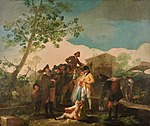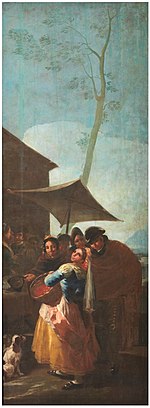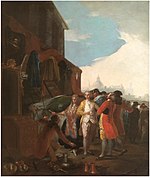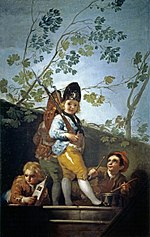
This is a complete list of Francisco Goya's 63 large cartoons for tapestries (Spanish: cartones para tapices) painted on commission for Charles III of Spain and later Charles IV of Spain between 1775 and 1791 to hang in the San Lorenzo de El Escorial and El Pardo palaces. The word "cartoon" is derived from the Italian cartone, which describes a large sheet of paper used in preparation for a later painting or tapestry. Goya's were executed on canvas which was then woven into wool tapestry to a large mural scale. While many of the large finished works are today in the Prado Museum, the original sketches were sold as works in their own right.
In 1774, Goya was asked by the German artist Anton Raphael Mengs, acting on behalf of the Spanish crown, to undertake the series. While designing tapestries was neither prestigious nor well paid, Goya used them, along with his early engravings, to bring himself to wider attention. They afforded his first contact with the Spanish monarchy that was to eventually appoint him court painter. The works are mostly popularist in a rococo style, and were completed early in his career, when he was largely unknown and actively seeking commissions. There is evidence that he later regretted having spent so much effort and time on the pieces, and that his later darker period, which begins roughly with Yard with Lunatics, was in part a reaction against them.
By 1776, aged 29, he had completed five tapestries, by the Real Fábrica de Tapices de Santa Bárbara, the royal tapestry manufactory. His brother-in-law Francisco Bayeu was made director of the tapestry works in 1777, which greatly advanced the ambitious artist's career prospects. However, Goya was beset by illness during the period, and his condition was used against him by the contemporary art scene, which looked jealously upon any artist seen to be rising in stature. Some of the larger cartoons, such as The Wedding, were more than 8 by 10 feet, and had proved a drain on his physical strength. Ever resourceful, Goya turned this misfortune around, claiming that his illness had allowed him the insight to produce works that were more personal and informal. However, he found the format limiting, because being inherently matte, tapestry was unable to capture complex colour shift or texture, and was unsuited to the impasto and glazing techniques he was by then applying to his painted works.
Dating the series has not been difficult as the Royal Tapestry Works maintained a detailed record of the dates, titles, sizes and states in which each of the cartoons arrived. Goya's letters to his friends (in particular his correspondence with the Aragonese industrialist Martín Zapater) contain additional details.
Groupings

The series can be divided into a number of groups based on intended location or theme. Art historians Valeriano Bozal and Nigel Glendinning arrange the series in four groups, whereas Janis Tomlinson places them in seven. The Goya catalogue of the Museo del Prado is closer to Tomlinson than to Bozal or Glendinning, but attempts to reconcile the two positions by grouping the cartoons into five sequences.
Goya had at first wanted to paint French or Dutch pastoral scenes, however Charles IV preferred "entertainments and clothing of the present time". This afforded Goya the opportunity to study closely his fellow citizens going about their daily lives, and allowed him to work outside of ecclesiastical commissions, which he often found dull and uninspiring. In general the cartoons are playful and depict the leisure activities of a variety of ages and social classes. Nine are hunting scenes that were for the dining room at the Escorial, which pleased the king's son—the future Charles IV—who was an avid hunter. A further ten were created for the dining room at El Pardo. The prince's wife, Maria Luisa, enjoyed the scenes of dancing and singing. The works are painted in the then-fashionable Rococo style, and heavily influenced by Antoine Watteau, whose work Goya came to know through his studies of Titian.
First series (1775)
| Tapestry | Spanish title | Date | Dimensions | Museum |
|---|---|---|---|---|
 |
La caza del jabalí | 1775 | 249 × 173 cm | Palacio Real (Madrid) |
 |
La caza de la codorniz o Partida de caza | 1775 | 290 × 226 cm | Museo del Prado (Madrid) |
 |
Perros y útiles de caza | 1775 | 112 × 174 cm | Museo del Prado |
 |
Caza con reclamo | 1775 | 112 × 179 cm | Museo del Prado |
 |
Cazador cargando su escopeta | 1775 | 289 × 90 cm | Museo del Prado |
 |
El cazador con sus perros | 1775 | 262 × 71 cm | Museo del Prado |
 |
El pescador de caña | 1775 | 290 × 226 cm | Museo del Prado |
Second series (1776–1778)
| Tapestry | Spanish title | Date | Dimensions | Museum |
|---|---|---|---|---|
 |
La merienda a orillas del Manzanares | 1776 | 271 × 295 cm | Museo del Prado |
 |
El baile de San Antonio de la Florida | 1776–1777 | 275 × 298 cm | Museo del Prado |
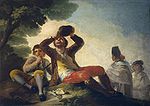 |
El bebedor | 1777 | 107 × 151 cm | Museo del Prado |
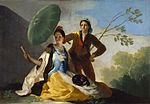 |
El quitasol (The Parasol) | 1777 | 104 × 152 cm | Museo del Prado |
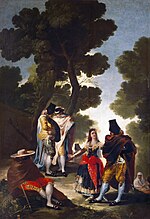 |
La maja y los embozados | 1777 | 275 × 190 cm | Museo del Prado |
 |
La riña en la Venta Nueva | 1777 | 275 × 414 cm | Museo del Prado |
 |
Jugadores de naipes | 1777–1778 | 270 × 167 cm | Museo del Prado |
 |
La cometa | 1778 | 269 × 285 cm | Museo del Prado |
 |
Muchachos cogiendo fruta | 1778 | 119 × 122 cm | Museo del Prado |
 |
Niños inflando una vejiga | 1778 | 116 × 124 cm | Museo del Prado |
Third series (1778–1779)
Fourth series (1779–1780)
| Tapestry | Spanish title | Date | Dimensions | Museum |
|---|---|---|---|---|
 |
El columpio | 1779 | 260 × 165 cm | Museo del Prado |
 |
El juego de la pelota a pala | 1779 | 261 × 470 cm | Museo del Prado |
 |
El médico | 1779 | 95.8 × 120.2 cm | National Gallery of Scotland |
 |
El balancín | 1780 | 95.8 × 120.2 cm | Museu de Belles Arts de València |
 |
Niños del carretón | 1778 | 30 × 43 cm | Toledo Museum of Art (Ohio) |
 |
La cita | 1779–1780 | 100 × 151 cm | Museo del Prado |
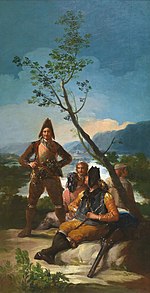 |
El resguardo de tabacos | 1779–1780 | 262 × 137 cm | Museo del Prado |
 |
Las lavanderas | 1779–1780 | 218 × 166 cm | Museo del Prado |
 |
Los leñadores | 1780 | 141 × 114 cm | Museo del Prado |
 |
La novillada | 1780 | 259 × 136 cm | Museo del Prado |
Fifth series (1786–1787)
| Tapestry | Spanish title | Date | Dimensions | Museum |
|---|---|---|---|---|
 |
Niños con mastines | 1786–1787 | 112 × 145 cm | Museo del Prado |
 |
Niño montando un carnero | 1786–1787 | 127.2 × 112.1 cm | Art Institute of Chicago (Illinois) |
 |
Las floreras | 1786–1787 | 277 × 192 cm | Museo del Prado |
 |
La nevada | 1786–1787 | 275 × 293 cm | Museo del Prado |
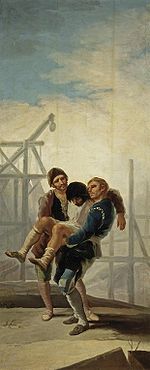 |
El albañil herido | 1786–1787 | 268 × 110 cm | Museo del Prado |
 |
Los pobres en la fuente | 1786–1787 | 277 × 115 cm | Museo del Prado |
| Riña de gatos | 1786–1787 | 56 × 193 cm | Museo del Prado | |
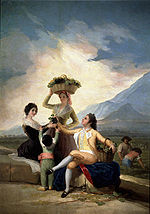 |
La vendimia | 1786–1787 | 275 × 190 cm | Museo del Prado |
 |
La marica en un árbol | 1786–1787 | 279 × 28 cm | Museo del Prado |
 |
La era | 1786–1787 | 276 × 641 cm | Museo del Prado |
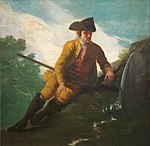 |
Cazador junto a una fuente | 1786–1788 | 130 × 131 cm | Museo del Prado |
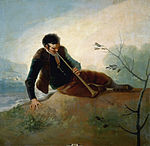 |
Pastor tocando la dulzaina | 1786–1788 | 130 × 134 cm | Museo del Prado |
Sixth series (1787–1788)
| Tapestry | Spanish title | Date | Dimensions | Museum |
|---|---|---|---|---|
 |
La pradera de San Isidro | 1788 | 44 × 94 cm | Museo del Prado |
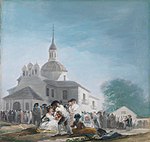 |
La ermita de San Isidro el día de la fiesta | 1788 | 42 × 44 cm | Museo del Prado |
 |
La gallina ciega (Blind man's bluff) | 1788–1789 | 269 × 350 cm | Museo del Prado |
 |
Merienda campestre | 1786 | 41.3 × 25.8 cm | National Gallery of London |
 |
Gato acosado | 1786 | 42 × 15.5 cm | Colección particular (Madrid) |
Seventh series (1791–1792)
| Tapestry | Spanish title | Date | Dimensions | Museum |
|---|---|---|---|---|
 |
Mujeres conversando | 1791–1792 | 59 × 145 cm | Wadsworth Atheneum (Hartford) |
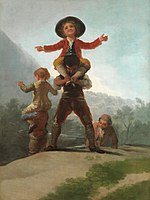 |
Las gigantillas | 1791–1792 | 137 × 104 cm | Museo del Prado |
 |
Los zancos | 1791–1792 | 137 × 104 cm | Museo del Prado |
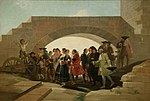 |
La boda | 1791–1792 | 268 × 320 cm | Museo del Prado |
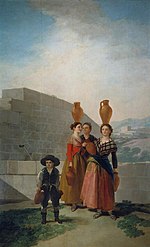 |
Las mozas del cántaro | 1791–1792 | 262 × 160 cm | Museo del Prado |
 |
Muchachos trepando a un árbol | 1791–1792 | 141 × 111 cm | Museo del Prado |
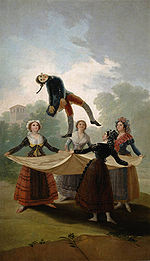 |
El pelele | 1791–1792 | 267 × 160 cm | Museo del Prado |
Sketches
| Tapestry | Spanish title | Date | Dimensions | Museum |
|---|---|---|---|---|
 |
Niños jugando a soldados | 1775 | 39 × 28 cm | Colección Yanduri (Sevilla) |
 |
El ciego de la guitarra | 1778 | - | Biblioteca Nacional (Madrid) |
 |
Los jugadores de naipes | c. 1777 | 86.5 × 59 cm | Winterthur Collection (Winterthur) |
 |
Las lavanderas | 1779 | 86.5 × 59 cm | Winterthur Collection (Winterthur) |
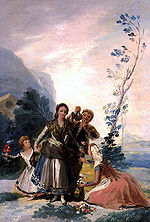 |
La primavera | 1786–1787 | 35 × 24 cm | Colección de Montellano (Madrid) |
 |
La trilla | 1786–1787 | 34 × 76 cm | Museo Lázaro Galdiano (Madrid) |
 |
The Grape Harvest | 1786 | 34 × 24.2 cm | Clark Art Institute (Williamstown) |
 |
El invierno | 1786–1787 | 34.3 × 36.6 cm | Art Institute of Chicago (Chicago) |
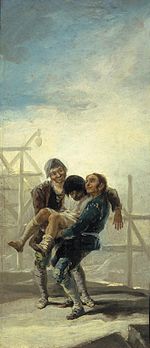 |
El albañil borracho | 1786 | 35 × 15 cm | Museo del Prado |
 |
Mujer y dos niños junto a una fuente | 1786–1787 | 18.5 × 3.5 cm | Thyssen-Bornemisza Museum (Madrid) |
 |
La gallina ciega | 1788–1789 | 18.5 × 3.5 cm | Museo del Prado |
 |
Mozas del cántaro | 1791 | 34 × 21 cm | Colección Paloma McCrohon (Madrid) |
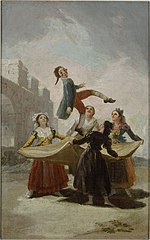 |
El pelele | 1791 | 35.6 × 23.2 cm | Hammer Museum (Los Angeles) |
See also
Notes
- "Cartoon". National Gallery, London. Retrieved 29 March 2010.
- ^ Grange, 43
- Hagen & Hagen, 7
- Hughes, 103
- Hughes, 44-45
- Hughes, 130
- Hughes, 83
- Bozal, Valeriano
- Glendinning, Nigel
- Cartones para tapices, Museo del Prado, 2008.
- Mena Márquez, Manuela de
- Hughes, 84
- "Francisco de Goya (1746–1828) and the Spanish Enlightenment". Metropolitan Museum of Art. Retrieved 27 March 2010.
- Hughes, 22
- Gassier, p. 84.
- Gassier, pág. 84.
- "Partida de caza". Museo del Prado (in Spanish). Madrid. Retrieved 22 March 2003.
- Museo del Prado, «Perros y útiles de caza». Retrieved 27 March 2010.
- Museo del Prado, «Caza con reclamo». Retrieved 27 March 2010.
- Museo del Prado, «Cazador cargando su escopeta». Retrieved 27 March 2010.
- Museo del Prado, «El cazador con sus perros». Retrieved 27 March 2010.
- Museo del Prado, «El pescador de caña». Retrieved 27 March 2010.
- Museo del Prado, «La merienda a orillas del Manzanares». Retrieved 27 March 2010.
- Museo del Prado, «El baile de San Antonio de la Florida». Retrieved 27 March 2010.
- Museo del Prado, «El bebedor». Retrieved 27 March 2010.
- Museo del Prado, «El quitasol». Retrieved 27 March 2010.
- Museo del Prado, «La maja y los embozados». Retrieved 27 March 2010.
- Museo del Prado, «La riña en la venta nueva». Retrieved 27 March 2010.
- Museo del Prado, «Jugadores de naipes». Retrieved 27 March 2010.
- Museo del Prado, «La cometa ». Retrieved 27 March 2010.
- Museo del Prado, «Muchachos cogiendo fruta». Retrieved 27 March 2010.
- Museo del Prado, «Niños inflando una vejiga». Retrieved 27 March 2010.
- Museo del Prado, «El ciego de la guitarra». Retrieved 27 March 2010.
- Museo del Prado, «El cacharrero». Retrieved 27 March 2010.
- Museo del Prado, «La acerolera». Retrieved 27 March 2010.
- Museo del Prado, «La feria de Madrid». Retrieved 27 March 2010.
- Museo del Prado, «El militar y la señora». Retrieved 27 March 2010.
- Museo del Prado, «Muchachos jugando a soldados»
- Museo del Prado, «El niño del árbol». Retrieved 27 March 2010.
- ^ It is difficult to determine to which series these works belong. (El majo de la guitarra, El columpio, El juego de la pelota a pala, El niño del árbol and El muchacho del pájaro.) Most critics place them in the third series, while Tomlinson places them in the fourth.
- Museo del Prado, «El muchacho del pájaro». Retrieved 27 March 2010.
- Museo del Prado, «El majo de la guitarra».Retrieved 27 March 2010.
- Museo del Prado, «El columpio». Retrieved 27 March 2010.
- Museo del Prado, «El juego de la pelota a pala». Retrieved 27 March 2010.
- National Gallery of Scotland, «El médico» Archived 2010-06-16 at the Wayback Machine. Retrieved 27 March 2010.
- Museu de Belles Arts de València, «El balancín». Retrieved 27 March 2010.
- Toledo Museum of Art, «Goya Thefth» Archived 2008-07-19 at the Wayback Machine. Retrieved 27 March 2010.
- Museo del Prado, «La cita». Retrieved 27 March 2010.
- Museo del Prado, «El resguardo de tabacos». Retrieved 27 March 2010.
- Museo del Prado, «Las lavanderas». Retrieved 27 March 2010.
- Museo del Prado, «Los leñadores». Retrieved 27 March 2010.
- Museo del Prado, «La novillada». Retrieved 27 March 2010.
- Museo del Prado, «Niños con mastines». Retrieved 27 March 2010.
- Art Institute of Chicago, «Boy with a ram». Retrieved 27 March 2010.
- Museo del Prado, «Las floreras». Retrieved 27 March 2010.
- Museo del Prado, «La nevada». Retrieved 27 March 2010.
- Museo del Prado, «El albañil herido». Retrieved 27 March 2010.
- Museo del Prado, «Los pobres en la fuente»
- Museo del Prado, «Riña de gatos»
- Museo del Prado, «La vendimia». Retrieved 27 March 2010.
- Museo del Prado, «La marica en un árbol». Retrieved 27 March 2010.
- Museo del Prado, «La era». Retrieved 27 March 2010.
- Museo del Prado, «Cazador junto a una fuente». Retrieved 27 March 2010.
- Museo del Prado, «Pastor tocando la dulzaina». Retrieved 27 March 2010.
- Museo del Prado, «La pradera de San Isidro». Retrieved 27 March 2010.
- Museo del Prado, «La ermita de San Isidro el día de la fiesta». Retrieved 27 March 2010.
- Museo del Prado, «La gallina ciega». Retrieved 27 March 2010.
- National Gallery of London, «A picnic». Retrieved 27 March 2010.
- ArteHistoria.com, «Gato acosado» Archived 2010-03-27 at the Wayback Machine. Retrieved 27 March 2010.
- ArteHistoria.com, «Mujeres conversando» Archived 2010-03-27 at the Wayback Machine. Retrieved 27 March 2010.
- Museo del Prado, «Las gigantillas». Retrieved 27 March 2010.
- Museo del Prado, «Los zancos». Retrieved 27 March 2010.
- Museo del Prado, «La boda». Retrieved 27 March 2010.
- Museo del Prado, «Las mozas del cántaro». Retrieved 27 March 2010.
- Museo del Prado, «Muchachos trepando a un árbol». Retrieved 27 March 2010.
- Museo del Prado, «El pelele». Retrieved 27 March 2010.
- Universidad de Zaragoza, «Niños jugando a soldados». Retrieved 27 March 2010.
- Biblioteca Nacional de España, «El ciego de la guitarra» Archived 2008-12-12 at the Wayback Machine. Retrieved 27 March 2010.
- Fundación Goya en Aragón, «Los jugadores de naipes». Retrieved 15 March 2020.
- Universidad de Zaragoza, «Las lavanderas». Retrieved 27 March 2010.
- Universidad de Zaragoza, «La primavera». Retrieved 27 March 2010.
- Museo Lázaro Galdiano, «La trilla». Retrieved 27 March 2010.
- Art Institute of Chicago, «El invierno». Retrieved 27 March 2010.
- Museo del Prado, «El albañil borracho». Retrieved 27 March 2010.
- Thyssen-Bornemisza Museum, «Mujer y dos niños junto a una fuente» Archived 2009-04-18 at the Wayback Machine. Retrieved 27 March 2010.
- Museo del Prado, «La gallina ciega». Retrieved 27 March 2010.
- Juan J. Luna (1996), «Mozas del cántaro». Retrieved 27 March 2010.
- Universidad de Zaragoza, «El pelele». Retrieved 27 March 2010.
Bibliography
- Bozal, Valeriano. Francisco Goya, vida y obra, Madrid, Tf, 2005, 2 vols. (Aficiones, 5-6). ISBN 978-84-96209-39-8.
- Gassier, Pierre and Juliet Wilson–Bareau. Vida y obra de Francisco Goya, Barcelona, Juventud. ISBN 84-261-5682-7.
- Glendinning, Nigel. Francisco de Goya, Madrid, Arlanza, Biblioteca «Descubrir el Arte», 2005. ISBN 84-95503-40-9.
- Hagen, Rose-Marie & Hagen, Rainer. Francisco Goya, 1746-1828. Taschen, 2003. ISBN 3-8228-1823-2
- Hughes, Robert. Goya. New York: Alfred A. Knopf, 2004. ISBN 0-394-58028-1
- Mena Márquez, Manuela de. Goya: guía de sala, Madrid, Tf, 2008. ISBN 978-84-95452-46-7.
- Tomlinson, Janis A. Francisco de Goya: los cartones para tapices y los comienzos de su carrera en la Corte de Madrid, Madrid, Cátedra, 1993. ISBN 84-376-1192-X.
- Francisco Goya. Kent: Grange Books, 2004. ISBN 1-84013-662-6
